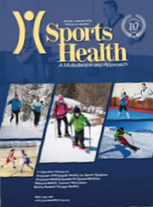Background: The King-Devick (K-D) test is a rapid number-naming task that has been well validated as a sensitive sideline performance measure for concussion detection. Patients with concussion take significantly longer to complete the K-D test than healthy controls. Previous research suggests that ocular motor deficits, specifically saccadic abnormalities, may be an underlying factor for the prolonged time. However, these findings have not been studied at length.
Hypothesis: K-D testing time of concussed adolescents at the initial clinical concussion visit will positively correlate with vestibular/ocular motor screening (VOMS) total scores.
Study Design: Case series.
Level of Evidence: Level 3.
Methods: A total of 71 patient charts were retrospectively analyzed between October 1, 2016, and January 31, 2017. Included charts consisted of patients between the ages of 10 and 18 years with a diagnosis of concussion and who had completed K-D testing and VOMS assessment at the initial physician visit. Univariate correlation between K-D testing time and the 7 VOMS items was assessed using Pearson correlation coefficients.
Results: K-D testing time strongly correlated with all 7 VOMS items (r(69) = 0.325-0.585, P < 0.01). In a linear regression model that accounted for each VOMS item, the convergence (near point) item and the visual motion sensitivity item significantly predicted K-D testing time (β = 0.387, t(63) = 2.81, P < 0.01 and β = 0.375, t(63) = 2.35, P = 0.02, respectively). Additionally, 37.5% of the 24 patients with worsening symptoms after K-D testing freely reported increased visual problems.
Conclusion: Our study suggests that prolonged K-D testing times in adolescents with concussion may be related to subtypes of vestibular/ocular motor impairment that extend beyond saccadic abnormalities.
Clinical Relevance: Poor K-D testing performance of adolescents with concussion may indicate a range of vestibular/ocular motor deficits that need to be further identified and addressed to maximize recovery.
Summary Points:
- K-D Test scores showed high correlation with vestibular-ocular performance.
- Near point of convergence and visual motion sensitivity significantly predicted K-D Test scores.
- K-D Test may be indicative of a range of vestibular and oculomotor deficits.
- Baseline measures are important in cases where individuals have a pre-existing vision condition that may affect test scores.
- As expected, the vertical and horizontal saccades significantly correlated with prolonged K-D time.
- Results suggest that prolonged K-D testing times may be related to vestibular/ocular motor impairment beyond saccadic abnormalities alone.

